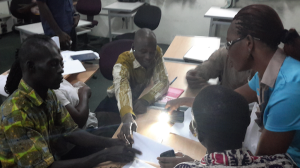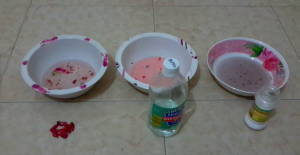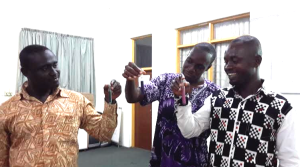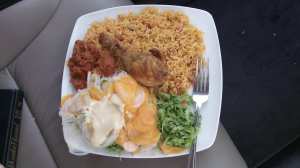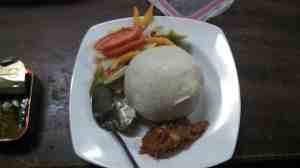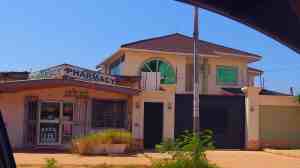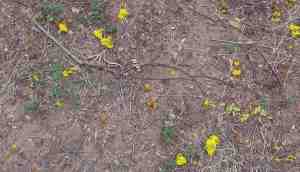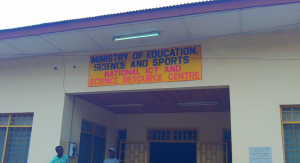
Our workshop location
Last day! I’m starting to get the hang of this.
Saddik started off the morning schedule by sharing some ideas on classroom management in large classes. It was good for him to share some of his expertise and it was a reminder that quality science education involves more facets than including hands-on activities. (My hypothesis though is that HOA are the most important factor to incorporate at this stage.)
After that, I wanted everyone to share the activities they created yesterday with the whole group, since there wasn’t time at the end of Day 2 to do so. That turned out to be a bit tricky, since most of the materials had been put back on the side, so people reverted to describing their designs with words. I placed the materials in front of them and asked them to re-build their designs, but it was hard to cold-start that process. Perhaps it’s hard to remember exactly what you did, or perhaps it’s hard to do when there are a bunch of people staring at you, or perhaps it takes some warm-up time to get into the mode of making.
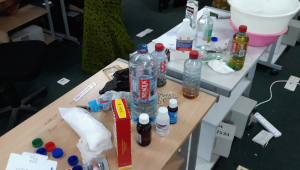
Some of the everyday materials we used
I asked for someone to demonstrate what they did in the electronics session, but this again deviated from where I was trying to lead things. One participant (who was part of the group that carefully sketched out their thoughts and made preliminary calculations before moving forward with any of their designs) shared what they reviewed about the theory of how different components work and led us step-by-step through identifying the resistance value of resistors based on the color bands. It’s nice that their team had worked together to cover the basic theory for those that were less familiar, but the participants were getting bored from sitting still that long.
I needed to somehow bring the practicality back into the conversation. I had noticed on my way into the building that morning, that there was a large circuit mounted on the wall next to the admin’s office. The cover was off, so all the components were visible. I told everyone to stand up and that we were making a quick field trip to see a real circuit. Everyone was excited to crowd in around the board and see the components they had learned about in use on a real thing (“those are capacitors!”, “these pieces are bigger than what we were using”, “we haven’t learned about that kind – what is that?”)! Embarrasingly, I don’t know what the circuit does (nothing was labeled, and I didn’t want to barge in on the admin’s office to see where the connections went), but at least there was a chance for the participants to see that what we were talking about is actually being used in things all around us.
By the time we all gathered back in our meeting room, one of the participants showed up with some old dusty circuits in his hands. I have no idea where he got them, but I was excited to see them exploring their surroundings to find more examples.
I ended the morning sessions with a few more quick-fire demos: lemon batteries, food tests (another topic in the syllabus) using local materials, and we played with some plant leaves that someone brought for testing of acidic properties. Making lemon batteries was very fun for them – they jumped into the activity, trying different types of coins, and immediately wanted to try to light the LEDs they were working with the day before. It drove home the point to me the deep need for training in and exposure to electronics. Only 2-3 of them had ever used (and seen?) a multimeter before. They said, “We don’t have those – they’re expensive”. I responded that we had bought one locally for $5, and they were surprised.
Just before lunch, the participants filled out an end-of-workshop survey to collect their perceptions comfort levels performing these experiments.
After lunch, we had a discussion session that I was looking forward to. I was worried because things were behind schedule, leaving us only about 30 minutes to discuss – “what are you going to do next?” “how can PEN be most helpful?”
To my great happiness, the general consent in the room was a hearty agreement that they would go back to their districts and lead their own workshops for their teachers. “As for the work, we will do it. We will do it.”
When I asked what they need to do a workshop right now, they only cited buying the materials and organizing the logistics to gather their teachers. Otherwise, they virtually all said that they were comfortable replicating everything they saw here. We didn’t need hours and hours to brainstorm and plan – they were ready to go.
More of my thoughts and analysis to come in a future post. But the quick version is that I finished the workshop in a state of simultaneous excitement and exhaustion.
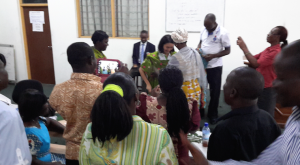
They presented me some African wear as a thank you

Some happy District Coordinators







